History of Amsterdam - Introduction to Amsterdam History from 1200 to Present
The history of Amsterdam is vibrant and rich.
After 1300, it grew fast to become the most powerful city in the world during the 17th century. From Amsterdam, explorers and traders sailed the world, founding among others New York.
Today, Amsterdam is one of the most international cities world-wide, known everywhere for it's tolerance and freedom-loving culture, receiving 4 million visitors annually. Amsterdam history is far from over.
1204 - 1585: Dam in the Amstel River
The history of Amsterdam began in the early 13th century, when fisherman built a dam across the Amstel river. The 'dam across the Amstel' became 'Aemstelledamme' in the oldest document mentioning the city (1204 AD), and later 'Amsterdam'.
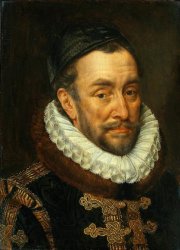
William of Orange
Amsterdam received city rights in 1300. Thanks to increasing trade with the Hanseatic cities in Europe, and becoming part of a pilgrim route, the city developed rapidly. A new self-conscious bourgeois class, separate from the old nobility and clergy, came into being. They would have a huge impact on the future history of Amsterdam.
During the 16th century, a new phase in the history of Amsterdam entered with the spread of Protestantism in the Netherlands. The suppression of Protestantism, together with the attempt to impose new high taxes on the Netherlands, led to a Dutch rebellion against it's official monarch, the Habsburg king Philip II of Spain, who was a fanatical Roman Catholic. The Dutch rebellion was led by William of Orange and led into the Eighty Years War.
In 1581, the Dutch seceded from the Catholic Habsburg empire and the confederal Netherlands became one of the first republics in the world, with a high degree of religious and social freedom.
1585-1672: The Golden Age
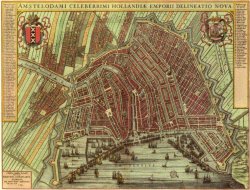
Map of Amsterdam in 1640
The religious was that raged throughout Europe, made many people flee to liberal Amsterdam: rich Jews from Portugal and Spain, rich merchants from Antwerp, scientists from many countries. It gave a tremendous boost to the city's financial centre, traders, manufacturers and culture. The population grew from 30.000 to 210.000 inhabitants.
Ships were built by the dozens each week, which sailed to North America, Brazil, Africa and Indonesia, to explore unknown continents and to trade. Part of their success was that the Dutch had better maps than anyone else. A worldwide network of trade routes, posts and colonies was established this way. The Dutch merchant and navy ships ruled the oceans.
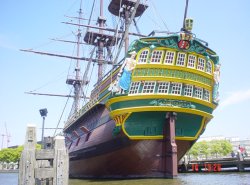
Rebuilt east-indiaman 'Amsterdam',
Amsterdam Shipping Museum
Bankers became rich through investments in these undertakings. The trading company VOC (United East Indian Company), founded in 1602, would become the world's first multinational company, and the world's first company to issue stock. In the same year, the world's first stock exchange (de 'Bourse') was opened in Amsterdam (which still exists as Euronext Amsterdam). Capitalism was born.
Culturally, Amsterdam was leading. Famous people like painter Rembrandt van Rijn, authors/poets P.C. Hooft and Vondel, and the composer Sweelinck lived and worked in the city. Books that were banned elsewhere, were printed in the Amsterdam, which became the publishing center of Europe.
Scientists Van Leeuwenhoek invented the microscope, Huygens the pendulum clock and Leeghwater invented a way to turn lakes and seas into polders (dry land), through which the Netherlands gained a quarter of it's land.
1672-1795: The Silver Age
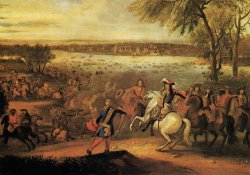
The French king Louis XIV
invades the Netherlands in 1672
The 'Year of Disaster', 1672, mark the end of the enormous rise in power, wealth and culture. England and France, attacked the Netherlands at the same time. The Netherlands would especially fight 4 naval wars with the British between 1652 and 1784.
Amsterdam and the Netherlands managed to consolidate their wealth in this period, but the naval wars with the British led to the end of the Dutch dominance of the oceans, and the rise of the British world empire ('Britannia Rules The Waves').
The world empire phase in the history of Amsterdam had ended.
1795-1814: The Monarchy Returns
The second half of the 18th century were defined by the conflicts between Orangists, who wanted more power for the stadholder William V of Orange, and the Patriots, who were inspired by the American and French revolutions and were in favour of tolerance and introduction of democracy.
When after the French Revolution, Napoleon's troops invaded the Netherlands and installed the principle of popular sovereignty, many Patriots backed them. However, the French revolution escalated, Napoleon crowned himself Emperor and - in 1806 - the Netherlands were turned into a monarchy and a unitary state, while they had been a decentralized confederacy before that.
When the old order defeated Napoleon, the united European kings convening in Vienna decided that the Netherlands should remain a monarchy, to function as a bulwark against possible new revolutionary aspirations of France. So the foreign monarchs put a member of the Orange family on the Dutch throne. Ironically, the new royal family annexed the old City Hall - symbol of the world power of the free Amsterdam citizens- and turned it into the Royal Dam Palace. A rather peculiar turn in the history of Amsterdam.
1814-1914: The Kingdom of the Netherlands
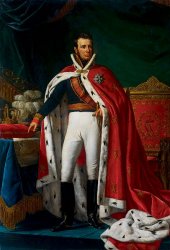
King William I
The new king William I kept himself rather busy with fostering industry and digging canals. The new monarchy included both the Netherlands and Flanders (Dutch-language Belgium), but Flanders wasn't happy in the union and seceded in 1830.
In 1848, revolutionary forces once again stirred up Europe. In the Netherlands, King William II was forced to accept a liberal constitution: there would be an elected parliament, division of powers and the monarchy was more and more reduced to a ceremonial function.
In the second half of the 19th century, the Netherlands joined the international race to get new colonies. The colonial empire was again enlarged, and would only be disbanded in the 1950s, largely under pressure from nationalist movements in the colonies, and the United States.
1914-1945: The World Wars
Before and after First World War, the Netherlands were neutral. While it's neutrality was respected during the First World War, the Germans did invade the country during the Second World War. No less than 105,000 of the 140,000 Dutch jews (who lived especially in Amsterdam, which always had a large Jewish community) were deported and murdered, among others due to the low resistance of the Dutch, including the now famous Anne Frank.
Especially the last war winter of 1944/45 is remembered as a hard time in the history of Amsterdam. Many people died because of food shortages.
1945-now: Amsterdam in the Modern Era
Contrary to e.g. the city of Rotterdam, which was heavily bombed during the war, the famous architecture of Amsterdam did survive the war in one piece. After the war, the country was rebuilt and a period of high economic growth began.
Amsterdam saw huge changes again during the 1960s, when the hippy and counter culture movements gained a very vocal following in the Netherlands. Nowhere was their influence bigger than in Amsterdam. Manifestations were held, the administrative center of the University of Amsterdam was occupied by protesting students, and hippies slept outside on Dam Square and in the Vondelpark. The libertarian period in the history of Amsterdam had begun.
The 1970s saw the introduction of the liberal drug policies that Amsterdam is so famous for. The idea was to allow soft drugs and suppress hard drugs at the same time. This way, it was hoped, both scenes would be separated and less people would 'progress' from soft to hard drugs.
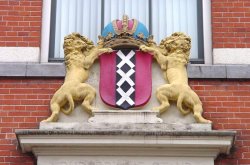
Amsterdam coat of arms
In the 1980s, squatting became a big issue too. Since Amsterdam was liberal in this respect too, squatters from all over Europe came to Amsterdam. A (then still) very generous social security system functioned as a basic income for many, including many artists. In 2001, the liberal pandemonium was complemented by the introduction of same-sex marriage. All these developments contributed to Amsterdam's reputation as a city where anything goes.
Tourism to Amsterdam began to increase. The city now sees some 4 million visitors (of which 2 million foreigners) each year. Amsterdam is still a city in possession of a huge art and music scene, the financial and business center of the country, the 12th busiest airport in the world and a harbor that's increasing in size and traffic again.
Amsterdam's population is young, well educated and always on the move: its two big universities and several colleges ensure that over 10% of the population (totaling 750,000) are students, and the high number of people who come and leave has led to the population being almost totally renewed every 10 years. The history of Amsterdam is far from over yet.
If you'd like to read more about the history of Amsterdam, a beautiful book is "Amsterdam: The Brief Life Of A City" by Geert Mak, one of the best (and most popular) Dutch history writers alive.
Related Pages:
- Recommended Amsterdam museums
- Overview of all museums in Amsterdam that receive over 25,000 visitors annually
- The Van Gogh Museum in Amsterdam
- The Rijksmuseum in Amsterdam
- A basic guide to Amsterdam
- From History Of Amsterdam back to Amsterdam Advisor

 Subscribe To
Subscribe To
